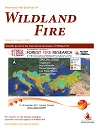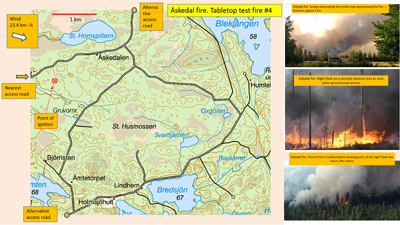International Journal of Wildland Fire
Volume 32
Number 3 2023
Special Issue
IX International Conference on Forest Fire Research and 17th International Wildland Fire Safety Summit (Part 2)
Guest Editors:
Miguel Almeida (Conference Scientific Committee, Coimbra, Portugal)
Michael Flannigan (Conference Scientific Committee Chair, Edmonton, Canada)
Luís Mário Ribeiro (Conference Co-chair, Coimbra, Portugal)
Domingos Viegas (Conference Chair, Coimbra, Portugal)
Part 2 of the Special Issue that resulted from the 9th International Conference on Forest Fire Research includes papers on various aspects of wildland fire research. Part 1 was published in January 2023. All papers in the Special Issue are published Open Access.
In regions with high wildfire potential but a low frequency of complex incidents, perceptions of wildfire behaviour can vary significantly among incident commanders. This study shows how incident commanders’ a priori understanding of wildfire affects their decisions during incidents, and how tabletop exercises can be used to extract such information.
In Pedrógão Grande on 17 June 2017, two fire-fronts merged and propagation of the fire was influenced by the interaction of these non-symmetric fire fronts. We found that the rate of spread for small rotation depended on the slope angle and the initial angle between fire fronts.
An understanding of junction fire – the intersection of two fire fronts – was built by a parametric study for the main geometrical parameters (slope and junction angles) using physics-based model FIRESTAR3D. The study found correlations between these angles and the change in intensity and modes of fire.
Natural wildfires on the Iberian Peninsula are caused by lightning strikes reaching locations with abundant vegetation, and are favoured by drought conditions that lower the moisture content of the fuels. Here, we developed a model able to forecast and map the likelihood of ignition at a daily timescale.
Modelling past fire behaviour using FDS at WUI scale taking into account refined vegetation distribution has rarely been attempted. The modelling was compared with past fire behaviour using different scenarios of vegetation management, sometimes highlighting that fuel reduction regulations could be strengthened when there is synergy between topography and wind.
Full-scale experiments were conducted to study the factors that influence ember accumulation near a building including building geometry, such as flat wall and re-entrant corners, building wind angle, wind speed and the surface roughness characteristics of the horizontal landscape close to the building.
In the present experimental study, 14 accidents related to LPG stored at the wildland–urban interface that occurred during wildfires are described. Tests with LPG cylinders exposed to fire using forest fuels were done to evaluate the safety devices and effects of explosions and jet fire.
Focused on the Portuguese wildfire management approach, this paper contributes to bridging a critical gap in knowledge on the role of spatial planning in the reduction of wildfire hazard, given that the characteristics of fire hazard are distinctive from other natural hazards (e.g. floods, costal erosion, earthquakes).
In this work, wildfire susceptibility, intensity and risk were obtained for the eastern Mediterranean and southern Black Sea basins. A methodology that combines machine learning techniques and empirical modelling is applied at a supranational scale characterised by a diverse climate and vegetation landscape, relying on open data.
The infrared thermal images of a propagating wildfire taken by aerial vehicles can help firefighting authorities in combat planning. We propose a method that is able to separate the wildfire into different temperature regions, which facilitates identification of the fire perimeter and location of the active front.






